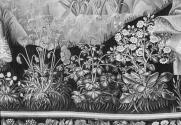Advanced Search
Tapestry: Scenes from the Manhood of Christ and from Christian Allegory (from the series The Redemption of Man)
Flemish (Brussels)
First quarter of the 16th century
Object Place: Brussels, Flanders
Medium/Technique
Wool warp; wool, silk, and gilt-silver wefts; tapestry weave
Dimensions
327 x 364 cm (128 3/4 x 143 5/16 in.)
Credit Line
Gift of the Hearst Foundation in memory of William Randolph Hearst
Accession Number54.1776
NOT ON VIEW
CollectionsEurope, Fashion and Textiles
ClassificationsTextiles
DescriptionThis tapestry is the sixth in a series of ten tapestries designed to illustrate the story of the redemption of mankind in terms of Christian allegory. Several scenese are shown including the Beheading of John the Baptist, John preaching, Woman taken in Adultery, Virtues arming Christian Knight, Baptism of Christ, Raising of Lazarus, and Charity challenging the Vices. Two seated male figures appear in lower corners, unidentified at left and David at right. Vine motif in border. Spot repairs.
Provenance1877, Duke of Berwick and Alba, Palacio de Liria, Madrid; April 7-20, 1877, Berwick and Alba sale, Hotel Drouot, Paris, lot 13 [see note 1], possibly to Baron Frederic Emile d'Erlanger (b. 1832 - d. 1911), Paris [see note 2]. 1922, Duveen Brothers, New York; 1922, sold by Duveen to William Randolph Hearst (b. 1863 - d. 1951), New York; to the Hearst Foundation, New York; 1954, gift of the Hearst Foundation to the MFA. (Accession Date: December 9, 1954)
NOTES:
[1] This was one of six tapestries sold at the time, from a series called Allegorical Subjects from the New Testament. [2] Baron d'Erlanger purchased a number of other tapestries at the Berwick and Alba sale. That the series of which this particular tapestry formed a part was in his collection is according to D. T. B. Wood, "Tapestries of the Seven Deadly Sins--I," Burlington Magazine 20, no. 106 (January, 1912), 215-216, 221. They may be the tapestries mentioned as being in the Erlanger collection by Gaston Le Breton, "Les tapisseries et les broderies anciennes," Gazette des Beaux-Arts 1882, p. 444 (called "moralités évangéliques").
NOTES:
[1] This was one of six tapestries sold at the time, from a series called Allegorical Subjects from the New Testament. [2] Baron d'Erlanger purchased a number of other tapestries at the Berwick and Alba sale. That the series of which this particular tapestry formed a part was in his collection is according to D. T. B. Wood, "Tapestries of the Seven Deadly Sins--I," Burlington Magazine 20, no. 106 (January, 1912), 215-216, 221. They may be the tapestries mentioned as being in the Erlanger collection by Gaston Le Breton, "Les tapisseries et les broderies anciennes," Gazette des Beaux-Arts 1882, p. 444 (called "moralités évangéliques").












